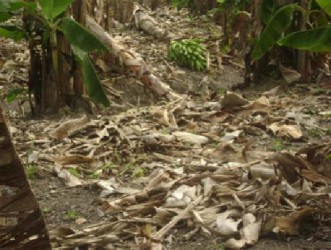Two technicians from Guyana are among a group to undergo intensive training in managing the Black Sigatoka, disease which the United nation’s Food and Agriculture Organisation (FAO) says led to the end of plantain exports from this country.
A release from the FAO yesterday said that as part of its response to the disease currently threatening the sucker crops it will be providing intensive training in management of the disease at a workshop to be held in Dominica from June 17 to June 22.
The workshop will train two technicians each from Dominica, St. Lucia, Grenada, Guyana and St. Vincent and the Grenadines.

Training, the FAO said, will focus on the effective use of fungicides to control and eliminate the disease. Technicians will be schooled to assess the disease’s sensitivity to specific substances and develop more effective treatment plans.
“Black Sigatoka Disease is considered far and away the most destructive disease to bananas and plantains. The disease affects the leaves, severely impacting the plant’s ability to produce fruit of good size and weight and causes premature ripening of the fruit, diminishing their export potential. The disease spores are carried by leaves and other planting material and as such can be spread easily from farm to farm and from country to country,” the FAO noted.
Black Sigatoka Disease first made its way to the Caribbean in 1991 and has spread throughout the region, it added. In St. Vincent and the Grenadines, the value of exports of the fruits were reduced by 90%, the FAO noted, while pointing out that exports of plantains from Guyana declined by 100% within two to three years of the disease establishing itself here.
While the disease remains prevalent here, in recent years the Ministry of Agriculture has not said much about it.
In July 2011, Stabroek News reported that the National Agricultural Research and Extension Institute (NAREI) had said that results from the Centre for Advanced Biomedical Imaging (CABI) in the UK stated that the disease was present in samples sent to it.
Farmers in the Parika area on the East Bank Essequibo, an area which had been hard hit by the disease, had told Stabroek News the problems they were having. A farmer in the Hog Island area, who asked not to be named, told this newspaper that he had been purchasing the fungicides which farmers had been advised by the Agriculture Ministry as being adequate to combat the disease. He said the fungicides have had some amount of impact but much more needed to be done including frequent visits by extension officers of the ministry.
The man said that another method which would see the containment of the disease was to clear the farming area which the disease has affected, but he noted that most of the farms at Hog Island were affected and as such this method would have been difficult for farmers.
NAREI had said then that areas around the country which were affected by the disease include parts of Regions 1, 2, 3, 4, 7, 8,10 and to a lesser extent in isolated areas of Regions 5 and 6.





